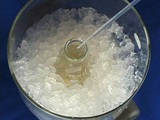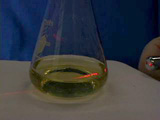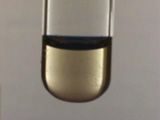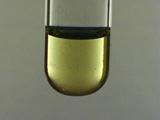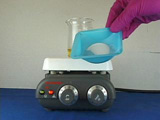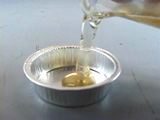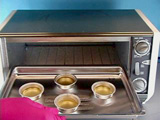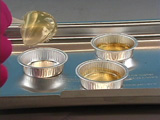
Silver Nanoparticle Stained Glass
The synthesis procedure shown here was adapted by Steve Ng and Chris Johnson from a procedure developed by S.D. Solomon, M. Bahadory, A.V. Jeyarajasingam, S.A. Rutkowsky, C. Boritz, and L. Mulfinger, Journal of Chemical Education, 84, 322-325, (2007).
The formation of silver nanoparticles can be observed by a change in color since small nanoparticles of silver are yellow. A layer of absorbed borohydride anions on the surface of the nanoparticles keep the nanoparticles separated. When sodium chloride (NaCl) is added the nanoparticles aggregate and the suspension turns cloudy gray. The addition of a small amount of polyvinyl pyrrolidone will prevent aggregation.
| Procedure | Wear eye protection |
 Never look directly into a laser or shine a laser at another person. |
Add 30 mL of 0.002M sodium borohydride (NaBH4) to an Erlenmeyer flask. Add a magnetic stir bar and place the flask in an ice bath on a stir plate. Stir and cool the liquid for about 20 minutes. Drip 2 mL of 0.001M silver nitrate (AgNO3) into the stirring NaBH4 solution at approximately 1 drop per second. Stop stirring as soon as all of the AgNO3 is added. The presence of a colloidal suspension can be detected by the reflection of a laser beam from the particles. Transfer a small portion of the solution to a test tube. The addition of a few drops of 1.5 M sodium chloride (NaCl) solution causes the suspension to turn darker yellow, then gray as the nanoparticles aggregate. Transfer a small portion of the solution to a test tube. Add a drop of 0.3% polyvinyl pyrrolidone (PVP). PVP prevents aggregation. Addition of NaCl solution then has no effect on the color of the suspension. Add enough solid polyvinyl alcohol (PVA) to give a 4% solution. To get the PVA to dissolve you will need to SLOWLY add it to the strirred, hot, silver colloid solution. Silver nanoparticles color the yellow stained glass in medieval churches. To make "stained glass" decant the mixture into a mold leaving air bubbles and undissolved PVA in the beaker. Evaporate in a toaster oven for 30 minutes. Alternatively the solution can be left to evaporate.
- Stock Solutions for 8 batches
- 0.001M AgNO3: Dissolve 0.017 g of AgNO3 into 100 mL distilled water. This solution can be kept for later usage.
- 0.002M NaBH4: Dissolve 0.0189 g of NaBH4 into 250 mL distilled water. This solution must be made fresh before the experiment.
- 0.3% PVP solution: Dissolve 0.1 g of PVP, Aldrich PVP-10, into 33 mL distilled water.
- PVA solid
-
Equipment
- Small Erlenmeyer flask
- 50 mL graduated cylinder (NaBH4)
- Large dish of ice
- Stirrer hotplate
- 1" stir bar
- 2 mL dropper (AgNO3)
- Laser pointer, polarizing filter
- mold
- Toaster oven or overnight drying
Developed in collaboration with the
University of Wisconsin Materials Research Science and Engineering Center
Interdisciplinary Education Group | MRSEC on Nanostructured Interfaces
This page created by George Lisensky, Beloit College. Last modified July 2, 2013 .
University of Wisconsin Materials Research Science and Engineering Center
Interdisciplinary Education Group | MRSEC on Nanostructured Interfaces
This page created by George Lisensky, Beloit College. Last modified July 2, 2013 .

